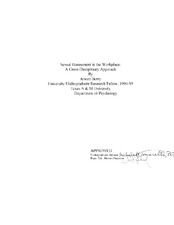| dc.description.abstract | In the last ten years, much attention has been focused on the issue of sexual harassment. During the mid-1980s, the Supreme Court ruled on the issue for the first time, and discussion about the ruling and sexual harassment in general began. The media attention given to events such as Tailhook and the Clarence Thomas appointment generated even more debate. Concerns were raised about what sexual harassment is and whose problem is it. Although some steps have been taken to answering these questions, there is still much confusion.
The purpose of this paper is to gain a better understanding of sexual harassment by coordinating the knowledge and expertise of historians, members of the legal community, and psychologists. The hope is to provide a cross-disciplinary view of the dynamics of sexual harassment. To do this we will examine women's involvement in the American workplace and how it evolved from the colonial period to the present day. We will look at how changing attitudes about female roles in society affected working women. After discussing how sexual harassment came about, we will then review the history of legal remedies to address it. Once the current legal situation is explained, we will move on to the psychological research done in this area. The feeling is that, after establishing a firm understanding of the evolution of sexual harassment, it will be possible to analyze the findings of the psychological community and discover ways to use their knowledge to more definitively address society's concerns, as well as generate solutions, for the sexual harassment problem.
Throughout the paper, targets of sexual harassment will be referred to in the feminine, and harassers in the masculine. The reason is that women are overwhelmingly the more frequent victim of sexual harassment, with males being the more common harasser. It is important to point out, however, that men can also be targets. Furthermore, unless otherwise noted, the word woman refers to the white, heterosexual woman. The preponderance of material, as will be discussed in greater detail later, focuses on this group of women. Research indicates that ethnicity and sexual orientation may have an impact on the dynamics of sexual harassment. Because no research has been done that directly examines these possibilities, we have chosen (with a few noted exceptions) to focus on this group as well, to ensure accuracy of information. | en |


